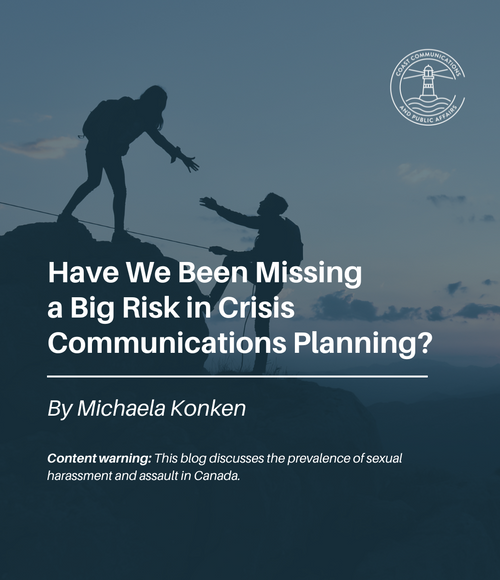By Laura Cropper, Associate at Coast Communications
In February and March, companies across Canada rushed to respond quickly to the rapidly escalating COVID-19 pandemic crisis.
That was the sprint, but now we are in a marathon. However, unlike a marathon’s standard 42 kilometers, no one can accurately predict the length of this COVID-19 phase. What is clear is health officials and governments alike agree that now is not the time to change direction.
As we adjust to our new—and uncertain—medium-to-long term normal, for many organizations, this second phase of COVID-19 looks more like ongoing implementation and maintenance. But as communications professionals and business leaders in our organizations, we must be proactive in how we manage though this uniquely challenging time.
Here are some of the top things you can do now, from a communications perspective, to ensure you are able to pivot in real time as the pandemic continues to evolve.
 Over the past two months, organizations dusted off their crisis communications plans and put them to the test. Undoubtedly, many crisis communications plans didn’t factor in the possibility of a pandemic, or one of this magnitude, creating a both a health and economic crisis so quickly. There is a good chance we will face a second wave of the disease in the fall before we have a vaccine or solid treatment, so ensure your plans reflect this possibility. Account for fall-out scenarios such as employee absenteeism, additional lay-offs, lack of supply chain continuity, suspension of business lines or closures. And, when moving from the theoretical to the practical, did you see any other shortfalls in your plan? Things that you could do better? Now is the time to refresh that plan in case COVID-19 continues to keep you in a crisis, you are in an even better position to respond efficiently and effectively.
Over the past two months, organizations dusted off their crisis communications plans and put them to the test. Undoubtedly, many crisis communications plans didn’t factor in the possibility of a pandemic, or one of this magnitude, creating a both a health and economic crisis so quickly. There is a good chance we will face a second wave of the disease in the fall before we have a vaccine or solid treatment, so ensure your plans reflect this possibility. Account for fall-out scenarios such as employee absenteeism, additional lay-offs, lack of supply chain continuity, suspension of business lines or closures. And, when moving from the theoretical to the practical, did you see any other shortfalls in your plan? Things that you could do better? Now is the time to refresh that plan in case COVID-19 continues to keep you in a crisis, you are in an even better position to respond efficiently and effectively. The media can play a key role in helping you share your story as to how you are operating in the new normal, or if you need to make a sudden announcement. But to be successful in working with the media takes training and practice. Remember that every interview is a strategic opportunity to get your message out rather than simply providing answers to the reporter’s questions. Effective media training is key to ensure you are equipped with the right tools and techniques to successfully deliver your message to your intended audiences.
The media can play a key role in helping you share your story as to how you are operating in the new normal, or if you need to make a sudden announcement. But to be successful in working with the media takes training and practice. Remember that every interview is a strategic opportunity to get your message out rather than simply providing answers to the reporter’s questions. Effective media training is key to ensure you are equipped with the right tools and techniques to successfully deliver your message to your intended audiences. When physical distancing measures ease and normal business operations begin to resume, organizations that have protected—and even enhanced—their relationship with employees, customers, partners and government will be in a better position to survive and thrive. We’re still in the thick of the COVID-19 pandemic, and there has been an enormous amount of change. Take the time now to listen to your various stakeholders. Gather qualitative and anecdotal information about your response, perception, ongoing concerns, audience needs and ideas about what you can do going forward. Consider what more you can do to support them..
When physical distancing measures ease and normal business operations begin to resume, organizations that have protected—and even enhanced—their relationship with employees, customers, partners and government will be in a better position to survive and thrive. We’re still in the thick of the COVID-19 pandemic, and there has been an enormous amount of change. Take the time now to listen to your various stakeholders. Gather qualitative and anecdotal information about your response, perception, ongoing concerns, audience needs and ideas about what you can do going forward. Consider what more you can do to support them.. Qualitative information is important, but you must also have quantitative data on which to base your actions. Conduct a deep dive social listening exercise; evaluate your analytics; conduct and employee and/or customer survey; code media relations results, if you don’t already. These are just some of the tactics you can implement to gather more information on which to base your actions.
Qualitative information is important, but you must also have quantitative data on which to base your actions. Conduct a deep dive social listening exercise; evaluate your analytics; conduct and employee and/or customer survey; code media relations results, if you don’t already. These are just some of the tactics you can implement to gather more information on which to base your actions.
 The COVID-19 situation is unprecedented in our lifetimes and presents unique challenges for us all. But the tried and true principles of communications best practices remain—and are in fact more important than ever as emotions run high, and stakeholders feel additional tensions and pressures. Go back to those tenets, and together with the qualitative feedback and quantitative data, adjust your communications practices and messaging to be proactive in our new paradigm.
The COVID-19 situation is unprecedented in our lifetimes and presents unique challenges for us all. But the tried and true principles of communications best practices remain—and are in fact more important than ever as emotions run high, and stakeholders feel additional tensions and pressures. Go back to those tenets, and together with the qualitative feedback and quantitative data, adjust your communications practices and messaging to be proactive in our new paradigm.



